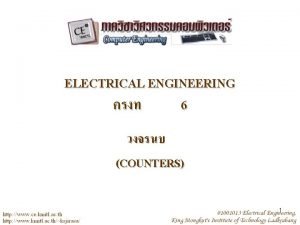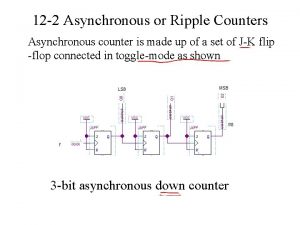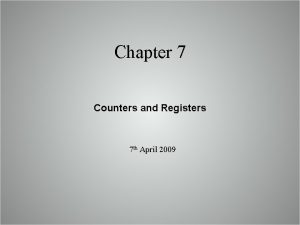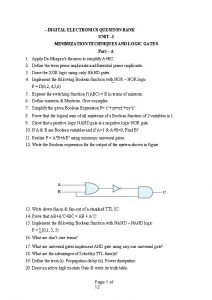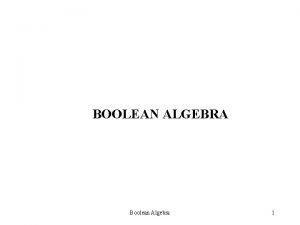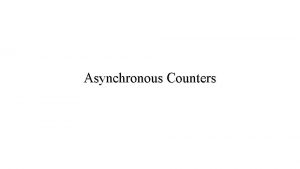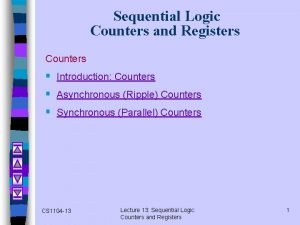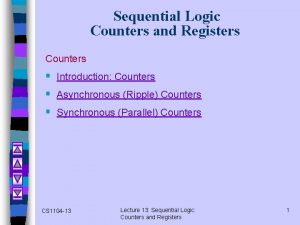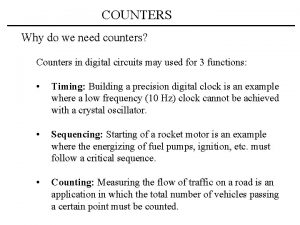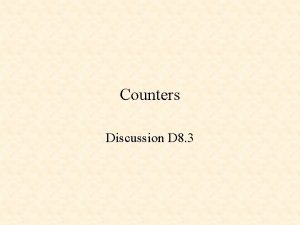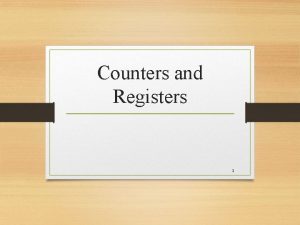Asynchronous Counter Digital Electronics Asynchronous Counters This presentation




















- Slides: 20

Asynchronous Counter Digital Electronics

Asynchronous Counters This presentation will: • Define asynchronous counters. • Define the terms states and modulus. • Provide multiple examples of asynchronous counters designed with D & J/K flip-flops. • Explain an asynchronous counter’s ripple effect. • Summarize the asynchronous counter design steps. 2

Asynchronous Counters • Only the first flip-flop is clocked by an external clock. All subsequent flip-flops are clocked by the output of the preceding flip-flop. • Asynchronous counters are slower than synchronous counters (discussed later) because of the delay in the transmission of the pulses from flip-flop to flip-flop. • Asynchronous counters are also called ripple counters because of the way the clock pulses, or ripples, its way through the flip-flops. 3

States / Modulus / Flip-Flops • The number of flip-flops determines the count limit or number of states: States = 2 (# of flip-flops) • The number of states used is called the MODULUS. • For example, a Modulus-12 counter (Mod-12) would count from 0 (0000) to 11 (1011) and would require four flip-flops (24 = 16 states; 12 are used) 4

Asynchronous Counter D-Flip Flop – 1 Bit Q 0 CLK 0 1 0 Repeats → 5

Asynchronous Counter Up Counter – D-Flip Flops – 2 Bit Note: Since we want Q 1 to toggle on the falling edge of Q 0, we must clock the second flip-flop from the of the first. Q 1 “ 0” “ 1” “ 2” “ 3” 0 0 1 1 Repeats → Q 0 CLK 0 1 6

Asynchronous Counter Up Counter – D-Flip Flops – 3 Bit Note: The CLKs are connected to the of the previous flip-flop. “ 0” “ 1” “ 2” “ 3” “ 4” “ 5” “ 6” “ 7” Q 2 0 0 1 1 Q 1 0 0 1 1 Q 0 0 1 0 1 CLK Repeats → 7

The Ripple Effect As the clock input “ripples” from the first flip-flop to the last, the propagation delays from the flip-flops accumulate. This causes the Q outputs to change at different times, resulting in the counter briefly producing incorrect counts. For example, as a 3 bit ripple counter counts from 7 to 0, it will briefly output the 7 6 4 0 count 6 and 4. 1 1 1 0 0 0 Q 2 1 0 Q 1 1 0 Q 0 1 0 CLK 8 1 m. Sec 100 n. Sec

Asynchronous Counter Down Counter – D-Flip Flops – 3 Bit Note: The CLKs are connected to the Q of the previous flip-flop. “ 7” “ 6” “ 5” “ 4” “ 3” “ 2” “ 1” “ 0” Q 2 1 1 0 0 Q 1 1 1 0 0 Q 0 1 0 1 0 CLK Repeats → 9

Asynchronous Counter Summary • Up Counters: Connect the CLK input to the Q output with the opposite polarity. • Down Counters: Connect the CLK input to the Q output with the same polarity. 10

Asynchronous Counter Up Counter – JK-Flip Flops – 3 Bit Note: The active low CLKs are connected to the Q of the previous flip-flop. “ 0” “ 1” “ 2” “ 3” “ 4” “ 5” “ 6” “ 7” Q 2 0 0 1 1 Q 1 0 0 1 1 Q 0 0 1 0 1 CLK Repeats → 11

Asynchronous Counter Down Counter – JK-Flip Flops – 3 Bit Note: The active low CLKs are connected to the of the previous flip-flop. “ 7” “ 6” “ 5” “ 4” “ 3” “ 2” “ 1” “ 0” Q 2 1 1 0 0 Q 1 1 1 0 0 Q 0 1 0 1 0 CLK Repeats → 12

Modulus Asynchronous Counter Up Counter – D Flip Flops – 3 Bit / Mod-6 (0 -5) Note: The upper limit of the count is 5; therefore, the reset circuit must detect a 6 (count +1). “ 0” “ 1” “ 2” “ 3” “ 4” “ 5” “ 0” “ 1” Q 2 0 0 1 1 0 0 Q 1 0 0 1 1 0 0 Q 0 0 1 0 1 RESET Repeats → 13

Asynchronous Counter Design Steps 1) Select Counter Type • Up or Down • Modules 2) Select Flip-Flop Type • D (74 LS 74) • J/K (74 LS 76) 3) Determine Number of Flip-Flops • 2 # Flip-Flops Modules 4) Design Count Limit Logic • Input to reset logic circuit is count limit plus one for up counters (minus one for down counters) 14

15

Asynchronous Counter Up Counter – D-Flip Flops – 3 Bit “ 0” “ 1” “ 2” “ 3” “ 4” “ 5” “ 6” “ 7” Q 2 0 0 1 1 Q 1 0 0 1 1 Q 0 0 1 0 1 CLK 16

Asynchronous Counter Up Counter – D-Flip Flops – 3 Bit “ 0” “ 1” “ 2” “ 3” “ 4” “ 5” “ 6” “ 7” Q 2 0 0 1 1 Q 1 0 0 1 1 Q 0 0 1 0 1 CLK 17

Asynchronous Counter Up Counter – D-Flip Flops – 3 Bit “ 0” “ 1” “ 2” “ 3” “ 4” “ 5” “ 6” “ 7” Q 2 0 0 1 1 Q 1 0 0 1 1 Q 0 0 1 0 1 CLK 18

Asynchronous Counter Up Counter – D-Flip Flops – 3 Bit “ 0” “ 1” “ 2” “ 3” “ 4” “ 5” “ 6” “ 7” Q 2 0 0 1 1 Q 1 0 0 1 1 Q 0 0 1 0 1 CLK 19

Asynchronous Counter Up Counter – D-Flip Flops – 3 Bit “ 0” “ 1” “ 2” “ 3” “ 4” “ 5” “ 6” “ 7” Q 2 0 0 1 1 Q 1 0 0 1 1 Q 0 0 1 0 1 CLK 20
 3 bit asynchronous counter
3 bit asynchronous counter Asynchronous counter
Asynchronous counter Pencacah sinkron dan asinkron
Pencacah sinkron dan asinkron Synchronous counter
Synchronous counter Modulo 60 counter
Modulo 60 counter Is camera an electronic device
Is camera an electronic device Setup time and hold time in digital electronics
Setup time and hold time in digital electronics Shift register with jk flip flop
Shift register with jk flip flop Digital vs analog signal
Digital vs analog signal Digital electronics question
Digital electronics question Ram digital electronics
Ram digital electronics Electronic components identification
Electronic components identification Boolen algebra
Boolen algebra System digital
System digital Arithmetic building blocks in digital electronics
Arithmetic building blocks in digital electronics 555 timer equations
555 timer equations Sequential programmable logic devices
Sequential programmable logic devices Nor as universal gate
Nor as universal gate Digital electronics chapter 1
Digital electronics chapter 1 Weighted and non weighted codes
Weighted and non weighted codes De morgan's law digital electronics
De morgan's law digital electronics

